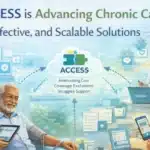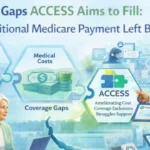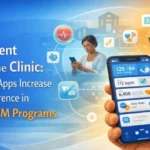CMS 2026 Proposed Rule Simplifies RPM: What Providers Need to Know

To promote remote care, the Centers for Medicare & Medicaid Services (CMS) has proposed major changes in the 2026 Medicare Physician Fee Schedule (PFS). This is a major alteration in favour of healthcare providers and another benchmark in CMS’s commitment to promote and incentivize remote care.
Medicare released the 2026 Proposed PFS on July 14, 2025. It aims to make Remote Patient Monitoring (RPM) more accessible, sustainable, and provider-friendly. This proposal is nothing short of transformative, especially for RPM providers struggling with out-dated thresholds and underutilized RPM programs.
In this blog, we will explore the core suggested changes and their impact on US-based clinicians, practices, and RPM providers.
Table of Contents
ToggleWhat’s New in the 2026 Medicare PFS Proposed Rule?
The Medicare PFS Proposed Rule 2026 aims to modernize and improve RPM services. The key highlight? Higher flexibility.
Over the years, providers and small practices have struggles with unbending billing requirements, resulting in limited data collection days. These constraints hindered providers’ ability to offer customized RPM programs for those in need of short-term monitoring or variable adherence.
CMS decided to embrace the evolving landscape of digital health to change that narrative. The proposed changes highlight that CMS recognizes that RPM does not mandatorily need long monitoring durations or intensive provider-patient interactions. By enabling a more adaptive, inclusive, and clinically relevant approach to RPM, CMS aims to loosen prior constraints and enhance flexibility for providers.
This will usher in a new era of better patient outcomes and provider-friendly reimbursement pathways.
What Are the New CPT Codes for RPM in 2026?
To expand reimbursement scenarios and promote adaptiveness, CMS has proposed two new CPT codes for RPM billing.
CPT 99XX4- For New RPM Device Supply
Currently, providers may bill CPT 99454 for RPM device supply and transmission if at least 16 days of physiological data are collected within a 30-day period.. To battle this, CMS proposed CPT 99XX4 that will allow providers reimbursement for 2 to 15 days of RPM data gathered in 30 days. This will help providers bill and get reimbursement at the same rate as CPT 99454.
The billing will help make short duration monitoring clinically meaningful, especially in situations like post-surgical recovery, medication titration periods, and short-term symptom monitoring.
This represents a paradigm shift toward value-based care, removing the “all or nothing” billing barrier that has historically limited provider compensation.
CPT 99XX5- New Short-Duration Clinical Time Code
The billing scenario today reimburses providers under CPT 99457 for 20 minutes or more of RPM-related clinical time per month. However, shorter patient interactions are often overlooked and remain non-billable. The new code CPT 99XX5 would allow providers to bill 10 to 20 minutes of clinical interaction, including reviewing data, making care decisions, and patient communication under RPM.
Reimbursement will be approximately 50% of CPT 99457 rates, providing compensation for shorter engagements that were previously uncompensated.. This new rule will help providers bill for quick interventions, follow-ups after unwanted readings, and managing low-acuity patients. Here’s a quick summary of the proposed RPM billing changes.
| Feature | Current Rule | 2026 Proposed Rule |
|---|---|---|
| Device Supply Code | CPT 99454: ≥16 days of data | CPT 99XX4: 2–15 days (same reimbursement) |
| Clinical Time Code | CPT 99457: ≥20 minutes | CPT 99XX5: 10–20 minutes (50% of 99457 payment) |
How Will the 2026 Rule Impact Healthcare Providers?
Every year, care providers eagerly await the annual release of the PFS, hoping for some positive alterations. The 1800-page PFS draft of 2026 brings several good news for providers in the form of benchmark proposals. The changes suggested are transformative for small clinics and rural providers and can significantly help overburdened care teams. Here’s the potential impact on healthcare providers-
- Expanded Patient Eligibility: The suggested changes widen the scope of eligibility criteria for Remote Patient Monitoring. Providers can now offer remote care to patients in need of short-term, event-based, or low-frequency monitoring. This ensures patients with newly diagnosed conditions, those undergoing lifestyle interventions, or those in need of transitional post-discharge care are also eligible to receive RPM services. Consequently, providers will be able to expand their customer base and generate more revenue.
- Heightened Compensation: Short interactions with patients that were previously non-billable are now eligible for reimbursement. Once approved, these changes will enable providers to bill for essential 10–15 minute touch points, such as medication adjustments or counselling following health data reviews. This will lead to heightened compensation for providers, ensuring that every minute of care counts.
- Increased Efficiency: The proposed changes allow care teams to log shorter interaction durations towards billable time. This will enable providers to distribute workload more effective, reduce burnout amongst staff, and increase workflow efficiency. Consequently, small practices can witness better results.
- Lower Barrier for RPM Adoption: By eliminating the 16-day data requirement, CMS aims to make RPM more accessible for smaller practices such as FQHCs and rural providers. Such care providers can now integrate RPM into their practices without large upfront investments or intensive monitoring infrastructure.
Through these suggested alterations, the CMS aims to make RPM more inclusive and financially rewarding for small care providers.
| Positive Impacts of PFS 2026 on Providers | |
|---|---|
| Pain Point | 2026 Solution |
| Lost Revenue on Short Interactions | CPT 99XX5 reimburses 10–20 minutes of clinical time |
| Rigid Device Data Rules | CPT 99XX4 allows 2–15 days of data for the same payment |
| Limited Patient Eligibility | Includes low-acuity & short-term monitoring patients |
| Staff Overload & Burnout | Shorter interactions now billable = better allocation |
What Do These Changes Mean for Patients?
Apart from offering exclusive benefits to providers, the newly proposed changes also unlock tangible advantages for patients. Here is how-
- Adaptable Monitoring Plans: RPM programs earlier were led by billing constraints, such as the requirement to collect at least 16 days of data to apply for reimbursement. This limited customizability amongst plans for patients, and they were offered more billable hours even when shorter durations were more appropriate.
With the proposed changes, care plans can now be tailored to clinical needs rather than being limited by billing requirements.. Whether a patient needs RPM for 5 or 25 days, they can receive adequate care, and providers can bill for it. - Access for Non-Chronic Conditions: RPM will no longer be restricted to managing chronic conditions lasting 12 months or longer. Providers can now accept shorter monitoring windows and benefit a broader patient base.
This includes those with post-operative care needs, sleep disorders, weight-management plans, physical rehabilitation, or transitional care, etc. This opens doors to complete health optimization and not just disease control. - Better Engagement and Results: Through personalized RPM plans and care, providers can ensure patient adherence and engagement at maximum levels. Patients are more likely to participate with enthusiasm in programs that are customized and attainable.
With flexible treatment and monitoring plans, patients feel less overwhelmed, and technology feels empowering rather than intrusive. Consequently, care becomes more collaborative and better results start appearing. With rigid compliance barriers no longer a part of RPM, patients want to use it instead of being obligated to tolerate it.
What Are the Financial Advantages for Providers?
The 2026 CMS rule ensures a financial win for healthcare organizations ready to grow their RPM offerings. Financial advantages of new PFS rules include-
- Stronger ROI with Faster Break-even: Reduced time and data thresholds imply that RPM programs do not need to wait for 30 days of high-frequency engagement to get returns. This makes piloting small-scale programs easy, resulting in scalability in consistent cash flow. This feature is extremely attractive to budget-conscious practices who wish to enhance the scope of services and income and make each care minute worthwhile.
- Increased Revenue Capture: Interactions below 20 minutes, such as a follow-up call after a concerning reading or counselling patients for 5-10 minutes, were previously uncompensated. With CPT 99XX5, these shorter engagements will now be considered billable, turning what was once unclaimed time into revenue. Scalability and Flexibility
Providers must no longer ensure 16+ days of device data or extended time for patient communication to receive reimbursement. This has expanded the scope of RPM to patients with short-term and low-risk requirements. This dramatically reduces the operational burden, allowing expansion in terms of customer base, earnings, and scope of services.
The expanded RPM codes allow new opportunities to flourish. Let’s have a look at a use case to understand the difference.
A patient received an eye surgery that requires short-term monitoring post-discharge. Earlier, RPM providers were not capable of billing for short-term remote monitoring for such patients who do not possess a life-threatening chronic illness. However, with the new code, the provider can offer post-operative remote care to patients, address their needs, help them with medications, and offer them counselling and empathy. Additionally, providers can bill for such services, even if the overall interaction is less than 20 minutes (which was earlier not accommodated).
This ensures that providers can bring RPM into wellness and preventive care realms as well. Here are a few use case opportunities now viable with the new proposed changes.
| Use Case | Why It’s Now Viable |
|---|---|
| Surgical Recovery | Short-term monitoring post-discharge is now reimbursable |
| Weight-loss & Wellness | Programs focused on prevention, not just disease |
| Sleep Apnea | Episodic conditions needing data-driven insights |
| Seasonal Vitals Tracking | Post-viral conditions like long COVID or flu can be monitored briefly |
How Does This Rule Fit Into Broader RPM Market Trends?
The 2026 PFS proposal is not just any regular adjustment. It highlights CMS’s vision for the way forward to realise its commitment to a patient-centred care environment. Through the proposed alterations, CMS has signalled a strategic shift to value-based care that focuses on outcomes and patient engagement over checkboxes and volume.
Additionally, it indicates accelerated adoption of telehealth throughout the U.S. By turning continuous monitoring into episodic visits based on individual requirements, RPM complements virtual care. The changes also aim to promote equity in access to care. With heightened flexibility in requirements, rural clinics and underserved populations can benefit more from Remote Patient Monitoring.
What Should Providers Do Now to Prepare?
The suggested changes open new avenues for RPM. However, only providers with initiative-taking preparation will reap its benefits. To stay ahead, practices must take steps to align operational workflows, train staff, and adapt advanced technology to maximize reimbursement potential. To help providers prepare for the upcoming changes, here are some key strategies they can adopt. Audit Your Patient List
Start by identifying patients from the existing list who could benefit from short-duration monitoring. This will include patients undergoing medication changes or those in early-stage lifestyle programs. Segment patients by needs and monitoring duration, and flag potential RPM candidates who can increase your revenue.
Tip: Target quick-win cases like patients with recent hospital discharge or a history of episodic symptoms first.
- Train Your Staff: Prepare your staff to track and note accurate interactions, especially those below 20 minutes, for a seamless reimbursement process. Train them about what qualifies as reimbursable time and helps them become familiar with the documentation requirements for the new codes. Additionally, help them learn to balance shorter engagements with patient care quality.
- Update RPM Protocols: You can now customize RPM protocols, given the flexibility in duration. Begin by designing shorter, condition-specific monitoring plans and updating internal RPM guidelines to align with the new code triggers. Adjust patient communication to make the most of the new flexibility in participation.
Example: Instead of sticking with a 30-day RPM cycle, offer short plans such as 7-day recovery monitoring or 14-day lifestyle tracking. - Plan Billing and Documentation Workflows: With considerable changes in the CPT codes coming through, providers need to configure EHRs and billing systems to integrate CPT 99XX4 and 99XX5. Billing teams must learn about eligible interactions and ensure documentation meets CMS guidelines.
What Challenges Should Providers Watch Out For?
The promising new flexibility isn’t free of challenges and considerations. It is therefore important to ensure clinical integrity and operational diligence. The considerations below can help you stay on the right track.
- Documentation Compliance- Although the codes reimburse for shorter interactions, CMS scrutiny will still be there. Providers must maintain clear records of patient engagement time and ensure that timing logs and communication records are traceable.
- Avoid Overbilling- Shorter codes do not imply the possibility of misuse or overbilling. Providers must not replace comprehensive monitoring with minimal check-ins until required with proof. Also, billing shorter codes without genuine clinical justification would be considered malicious. CMS will monitor trends and abuse patterns, and thus, providers must bill the new codes only when truly appropriate.
- Balance Flexibility with Quality- In the run to scale operations and utilize flexibility for more reimbursement, do not compromise on care quality. Providers must maintain continuity of care, especially for patients transitioning to long-term monitoring. Preserving the depth of care while widening the funnel would lead to desired results.
What Is the Future of RPM Under Medicare?
The CMS 2026 proposal is a milestone and a stepping stone towards broader innovation in the arena of remote patient monitoring. Here is a sneak peek of what can be expected in the coming years.
- Flexibility in Other Programs- CMS may decide to expand the flexibility to other remote programs, such as Remote Therapeutic Monitoring (RTM) and Chronic Care Management (CCM). This would help unify digital health reimbursement and contribute to CMS’s vision of adaptive and modernized care.
- Greater Integration of Tech- Use of soft-tech, such as consumer-grade and medical-grade wearables (smartwatches, sleep trackers, etc.) will increase. Due to shorter data requirements and lower infrastructure thresholds soon, the adaptability of these technologies in patients’ healthcare regimes will probably witness a boost.
- Strengthened Collaboration Between PCPs and RPM Vendors– The low entry barriers will push small primary care providers (PCPs) and community clinics to integrate RPM, thus fostering collaboration with RPM solution vendors. Together, these two can co-manage patient populations and deliver hybrid care models that are a blend of in-person and remote care.
Through these significant changes, CMS is clearly signaling a shift towards practice and data-driven care. This change reflects a broader shift in how, when, and where healthcare is delivered.
What Is the CMS Timeline for RPM?
2019: Initial RPM code introductions (99453–99458)
2020–2021: Telehealth surge during COVID
2022: Clarifications on data requirements
2024: Reimbursement rule updates
2026: Flexible data & time thresholds introduced
HealthArc- Your End-To-End RPM Partner
In the scenario of such a paradigm shift, HealthArc stands out as a leading RPM provider, offering a fully integrated, turnkey RPM platform. With HealthArc, PCPs can co-manage patient populations with clinical intelligence and oversee transitional care using real-time vitals and data. Our Remote Patient Monitoring is integrated with AI-powered alerts, helping providers intervene before conditions worsen.
With HealthArc’s plug-and-play RPM platform, providers can build hybrid care programs like chronic disease management, post-discharge recovery programs, and preventive care. In light of the new proposal, RPM integration services by HealthArc can help you train your staff and maximize your reimbursement potential.
PFS 2026 Proposal- A Strategic Win for Everyone
It is safe to say that the 2026 Medicare PFS proposed changes to RPM offer a win-win situation for all the stakeholders.
For patients, this refers to more options and better outcomes.
For providers, it unlocks the door to greater revenue and scalability.
For the overall healthcare system, it serves as a milestone in the shift towards patient-centric and proactive care.
Key Takeaways
- CMS 2026 simplifies RPM billing with new CPT codes.
- Small and rural practices stand to gain the most.
- Patients benefit from shorter monitoring periods and broader eligibility.
- Providers must update workflows, documentation, and training before Jan 2026.
- Partnering with an experienced RPM vendor ensures compliance and revenue capture.
Frequently Asked Questions (FAQs)
The CMS has suggested two new CPT codes for billing patient interaction under Remote Patient Monitoring. These codes will allow providers to bill for interactions lasting less than 20 minutes. Moreover, the prior requirement of a minimum of 16 days of care for billing will be waived once the suggestions are approved.
The CMS suggested two new codes for RPM billing, which include CPT 99XX4 – For New RPM Device Supply and CPT 99XX5 – New Short-Duration Clinical Time Code.
The CMS aims to make remote care benefitting for the patients and rewarding for small providers. The suggested changes will help small and rural practices gain better access to RPM reimbursement and bill for short durations of care. Also, it will help patients receive customized care plans and better results.
In addition to chronic conditions lasting 12 months or more, short-term or episodic issues will also be covered under RPM if the suggested changes are approved. This includes post-surgery recovery, weight management, sleep issues, etc.
Once approved, the CMS will put the new rules into effect starting January 1, 2026, as part of the 2026 Medicare Physician Fee Schedule.
CMS 2026 raises RPM reimbursements and simplifies pricing, creating stronger revenue opportunities — learn more here.
Most Recent Blogs
Categories
Related Blog
- December 24, 2025 | Read Time: 7 mins
What Is Patient-Centered Care? Benefits, Key Principles, and Real-World Examples
Patient-centered care is one of the most important ideas shaping how healthcare...
Learn More- December 19, 2025 | Read Time: 12 mins
Engagement Beyond the Clinic: How Mobile Apps Increase Patient Adherence in RPM and RTM Programs
Through the introduction of Remote Patient Monitoring (RPM) and Remote Therapeutic Monitoring...
Learn More- December 15, 2025 | Read Time: 10 mins
G2211 CPT Code: Complete Description, Billing Guidelines & Reimbursement
G2211 CPT code is an add-on HCPCS code that lets you capture...
Learn More


